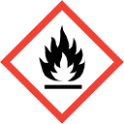Transportation recognition
Subject to some exceptions, road transport regulations require vehicles carrying explosives to be marked with placards in accordance with the regulations. For detailed information refer to the Foundation for hazardous materials – Transportation and packaging.

Figure: Transportation hazard warning diamond for UN Hazard Division 1.1 to 1.3 and Compatibility Group
The ‘bomb burst’ pictogram indicates that the UN classification system recognises that UN Hazard Division 1.1 to 1.3 possess the energy to mass detonate/deflagrate.

Vehicles carrying larger quantities of explosive materials, including fireworks, should carry the appropriate UN Hazard Division orange diamonds. However, fire and rescue services should be aware of the possibility of smaller loads of explosives being carried in vehicles without placards and of explosives being illegally carried. Incident commanders should always consider these possibilities if, for example, the driver of the vehicle involved cannot be easily identified at the incident.
Vehicles carrying more than five tonnes of UN Hazard Division 1.1 explosives must have a driver and attendant (carrying less than five tonnes or carrying materials from other hazard divisions mean no attendant is required); both will have received specific training to the Agreement concerning the International Carriage of Dangerous Goods by Road (ADR) standard that enables them to take measures for their own safety, that of the public and the environment. Therefore, the vehicle crew should always be consulted.
All packages and the vehicle must be correctly identified in accordance with the Carriage of Dangerous Goods and Use of Transportable Pressure Equipment Regulations 2009. The package labels and vehicle placards provide safety information for those involved in transportation and the emergency services, and must be displayed at all times.
On those occasions when the armed forces, in the interest of national security, do not comply with the carriage regulations, liaison with the crew of the vehicle is paramount.
Although small quantities of explosives may be carried in private vehicles without having to comply with the carriage regulations, the carrier still has a responsibility to move them safely and securely.
Even though up to 2kg of one or more specific items may be carried on public transport these items must remain with the person carrying them, be properly packaged and reasonable precautions must have been taken to prevent accidents.
Rail transport of explosives is strictly controlled under railway transport legislation. Explosives are clearly marked and packed in specific wagons or containers. Placards like those required for road transport are displayed on both sides of the wagon and on all four sides of containers. Written information is carried by the crew, detailing the explosive carried and any special action required. The crew will also have received specific training similar to that of road vehicle crews but to the Regulation concerning the international transport of dangerous goods by rail (RID) standard. Crews should always be consulted at an incident.
For further information on rail transportation hazards refer to Transport.
Unless a licence has been granted, marine and inland waterways legislation prohibits (with certain exceptions):
- Explosives being brought into, or handled in, a harbour
- Loading/unloading explosives on a vessel
When this occurs on any part of the coast or in the tidal waters or within the territorial waters of the United Kingdom:
- The licence specifies any conditions or restrictions, including limits on the type and quantities of explosive handled and where in the harbour area the handling may take place
- Once the loading/unloading of a vessel or a vehicle is completed, the master of the vessel or the operator of the vehicle shall ensure that the vessel or vehicle is taken out of the harbour or harbour area as soon as is reasonably practicable, unless agreed by the harbour master and, if berthed, the berth operator
- Vessels carrying dangerous goods will display a red warning flag between sunrise and sunset and, when moored or anchored between sunset and sunrise (or during the day when there is restricted visibility), will display an all-round, uniform and unbroken red light
- The operator of any berth where explosives are being loaded/unloaded or stored before being loaded/unloaded shall ensure that their emergency plan is made available to the fire and rescue services
All Royal Navy vessels have a liaison officer who will inform the appropriate fire and rescue service whenever the vessel is in port.
For further information on marine transportation hazards, refer to Transport.
Site recognition
Licensed sites and military establishments storing and using explosives should conform to UK legislation and regulation. For further information, see A foundation for hazardous materials.
Supply and packaging recognition
Under The European Regulation (EC) No 1272/208 on classification, labelling and packaging of substances and mixture (the EU version of the Globally Harmonised System (GHS)), the symbols that can be seen in relation to explosive materials are:
For detailed information on classification and labelling see Foundation for Hazardous Materials.


